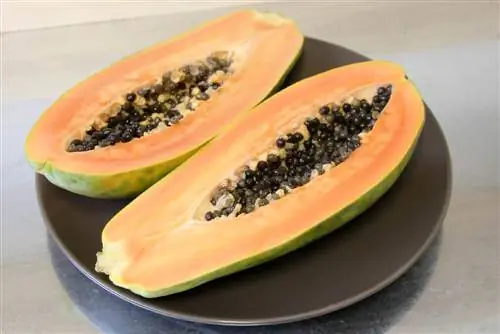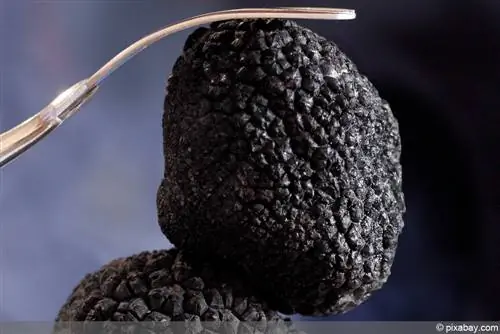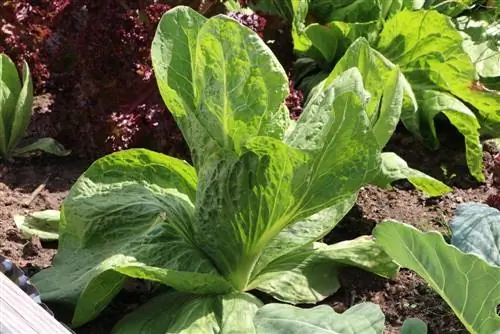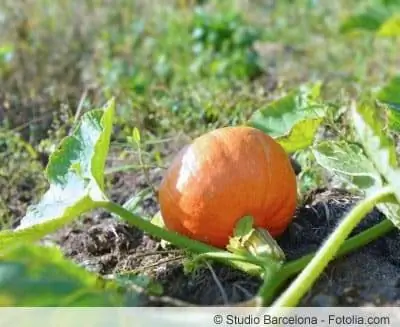- Author admin [email protected].
- Public 2023-12-17 03:39.
- Last modified 2025-01-24 12:45.
The pumpkin originally comes from the warm climate zones of the tropics and subtropics, so cultivation in the local latitudes with significantly colder temperatures is somewhat limited, but with a few tricks and good prior knowledge it is definitely possible. Even in a small garden with manageable beds, pumpkins can be planted and the gardener can expect a rich harvest. Due to the wide selection of varieties, there is the right variety for every taste, and non-edible ornamental pumpkins can also be cultivated, which are ideal for decorating.
Variety variety
There is now a large selection of varieties that can be cultivated; personal taste preference plays an important role in choosing the right variety. Due to its delicious pulp, pumpkin is very popular all over the world and is an important ingredient in many dishes. The pumpkin is native to tropical Central America and has spread from there to Eurasia. The following aspects must be taken into account when it comes to variety:
- impresses with tasty pulp, different flavors depending on the variety
- Difference between vegetable pumpkins and ornamental pumpkins
- Decorative pumpkins are not suitable for consumption, they only serve decorative purposes
- Decorative pumpkins are much smaller and have unusual shapes, very popular at Halloween
- Garden, giant and musk pumpkins are among the most important varieties
- there are round varieties and bottle gourds with an elongated shape
- The butternut squash is particularly delicious
- The pumpkin family also includes zucchini
Growth, leaves & flowers
The pumpkin is not only a delicious vegetable plant, but also an ornament for every garden. The large foliage of the climbing plant quickly forms a dense canopy of leaves and in the summer months a lush flower crown forms. Both male and female flowers occur on the same pumpkin plant:
- annual, low-lying and herbaceous plant
- climbs upwards with multi-columned tendrils
- can reach growth lengths of up to 10 m
- angular and thick stems, covered with stiff hairs
- alternate, stalked and mostly five-lobed leaves
- bell-shaped and bright yellow flowers, up to 7 cm wide
- Flowering period June-August
Location & Soil
Pumpkin plants need a lot of space to thrive, especially the large varieties need sufficient distance from their neighbors. In addition, pumpkins require a lot of light; if they are kept too dark, a large number of leaves and flowers will be produced, but the fruits will remain much smaller than in a sunnier location. The following criteria are crucial for the location and the soil:
- prefers humus-rich and well-drained soil
- Warmth of the soil should be 15-21 ºC
- A sunny to full sun location is ideal, shady places minimize the harvest
- needs over 6 hours of blazing sun every day
- requires a lot of space
- Plant large varieties at a distance of approx. 5 m
- improve the soil with compost before planting
Tip:
Due to the high nutrient requirements of pumpkin plants, it is advisable to plant them in the compost heap. This visually obscures the often unsightly appearance of the compost heap and the large leaves of the pumpkins provide shade for the compost in the summer months.
Sowing & Planting
Pumpkin plants are extremely sensitive to frost, which is why they may only be planted outside after the last night of frost. In addition, the pumpkin is susceptible to viral diseases, to avoid these it is recommended to plant it alone:
Oilseeds are used as seeds and can be stored for up to 5 years
- prefer robust varieties that tolerate cold better
- Varieties that are too sensitive only produce inferior fruit sets
- cultivate the heat-loving plants in the pot before putting them out
- Sowing in warm living rooms or winter gardens from the beginning of April
- Put the pumpkin seeds in the pot with the tip facing down
- The root then grows from the tip
- Do not plant seeds too deep, approx. 1-1.5 cm into the planting substrate
- After approx. 1 week the first seedlings will form
- After another 2-3 weeks, transfer seedlings to individual pots
- only transfer to the garden after the Ice Saints, from mid-May
- A separate location, without direct plant neighbors, is ideal
- The company of cucumbers and zucchini is tolerated
Tip:
If older seeds are used, they often only germinate irregularly and the harvest yields are usually unsatisfactory. For this reason, the seeds should be as fresh as possible.
Watering & Fertilizing
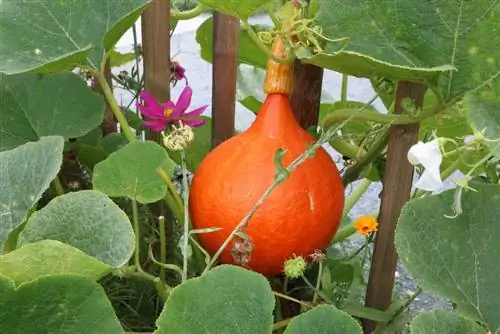
If the pumpkin is not watered enough, growth stops and the harvest fails. In addition, the plant has a high nutrient requirement and must therefore be fertilized often. The following aspects must be taken into account when watering and fertilizing:
- relatively easy to care for plant
- pay attention to regular watering
- pour directly onto the ground
- Do not wet the leaves during the watering process, otherwise they tend to rot
- dissolve nitrogen-rich complete fertilizer in irrigation water, ideally fertilize weekly
Harvesting & Propagation
The pumpkin is not only very easy to care for, but also very tasty and can be used in many dishes. The fruits develop after the flowering period and can reach extreme sizes to the delight of every gardener. The following procedure has proven successful for harvesting and propagation:
- Orange to greenish fruits develop at the end of summer
- have a tough and leathery skin, the flesh is firm and fibrous
- round to oblong shapes are possible, normal diameter is 40 cm
- Large specimens can reach gigantic proportions
- Harvest time is between September and October
- Separate pumpkins from the plant with a sharp knife
- countless seeds develop inside the armored fruit
- Seeds have an oval and flat shape, with a clear edge
- Dry and store seeds, use for propagation next spring
Diseases & Pests
The pumpkin is a relatively sensitive plant, which quickly tends to develop diseases and pests if not cared for properly and in unsuitable location conditions:
- Long-term excessive humidity leads to mildew infestation
- Mildew covers leaves with an unsightly gray haze
- If infested in late summer, there is little danger to the fruits
- tends to viral diseases, especially from incorrect plants in the neighborhood
- Viral diseases lead to the complete death of the plant before it bears fruit
Conclusion
Pumpkins are relatively easy-care plants that thrive magnificently in the right location conditions and produce lots of large fruits. Due to the large variety of varieties, there are varied flavors and a wide range of shapes. The large-growing varieties can reach extreme sizes, a factor that must be taken into account when selecting a location. However, the pumpkin is very warm-loving and must therefore be grown in living rooms or winter gardens before being released outdoors. The plant should be cultivated in a solitary position, because unsuitable plant neighbors can cause pumpkins to become infected with viruses and die.
What you need to know about pumpkin cultivation in brief
General
- Pumpkins actually originate from tropical or subtropical climates.
- Cultivation is therefore somewhat limited in our much colder areas, but not impossible.
- Pumpkins can even be planted in your own small garden or bed. But how?
Seeds and sowing
- Pumpkin seeds are oilseeds, like sunflowers.
- The seeds can be stored for up to five years.
- If you use it later, it will only germinate irregularly and the yields may be unsatisfactory.
- If you want to grow pumpkins in our climate zones, you should choose robust varieties.
- A sensitive variety may not develop properly, so that instead of a whole fruit, only rudiments can be seen.
- Since pumpkins are warm-loving due to their origin, they should be cultivated in a pot before planting.
- The pumpkin seeds have a tip that must be placed downwards as the root will sprout here.
- The seeds should not be planted too deep, only about 1 to 1 1/2 cm deep in the soil.
- The first seedlings should have formed after about a week.
- After another two to three weeks, the seedlings will be large enough to be placed in individual small pots.
- However, they are only allowed outside after the Ice Saints, when there is no longer any risk of frost.
Pumpkin in the garden
- When the Ice Saints are over and it gets warm outside, the seedlings are transplanted into the garden.
- It should be ensured that the individual plants have enough space.
- Depending on the variety, each pumpkin should be able to take up one to two square meters of space.
- Pumpkins require heavy, nutrient-rich soil. Compost heaps are therefore particularly suitable.
- A good potash content in the soil is important. Some varieties also thrive very well on sandy, permeable soil.
- It is also essential to water the pumpkin plants well while they are very young.
- Once they get a little bigger, additional watering is no longer absolutely necessary.
- However, if a dry period occurs in summer, watering must be carried out again.
- For good yield results, secondary shoots can be removed from mid-June so that a plant does not produce more than two fruits.
- Harvest time is from the end of August to around mid-November, before the first frost.
- You can recognize a ripe pumpkin by its bright color, woody stem and hollow sound when you hit it lightly.


